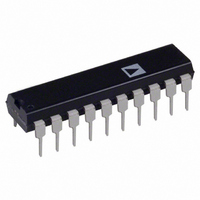AD670JN Analog Devices Inc, AD670JN Datasheet - Page 10

AD670JN
Manufacturer Part Number
AD670JN
Description
IC ADC 8BIT SGNL COND 20-DIP
Manufacturer
Analog Devices Inc
Datasheet
1.AD670JNZ.pdf
(12 pages)
Specifications of AD670JN
Rohs Status
RoHS non-compliant
Number Of Bits
8
Sampling Rate (per Second)
10k
Data Interface
Parallel
Number Of Converters
1
Power Dissipation (max)
450mW
Voltage Supply Source
Single Supply
Operating Temperature
0°C ~ 70°C
Mounting Type
Through Hole
Package / Case
20-DIP (0.300", 7.62mm)
Available stocks
Company
Part Number
Manufacturer
Quantity
Price
Part Number:
AD670JN
Manufacturer:
ADI/亚德诺
Quantity:
20 000
Company:
Part Number:
AD670JNZ
Manufacturer:
DIODES
Quantity:
12 000
AD670
STRAIN GAGE MEASUREMENTS
Many semiconductor-type strain gages, pressure transducers,
and load cells may also be connected directly to the AD670.
These types of transducers typically produce 30 mV full-scale
per volt of excitation. In the circuit shown in Figure 15, the
AD670 is connected directly to a Data Instruments model JP-20
load cell. The AD584 programmable voltage reference is used
along with an AD741 op amp to provide the 2.5 V excitation
for the load cell. The output of the transducer will be 150 mV
for a force of 20 pounds. The AD670 is configured for the
ounces per LSB over a range of 17 pounds. Scaling to exactly
2 ounces per LSB can be accomplished by trimming the refer-
ence voltage which excites the load cell.
MULTIPLEXED INPUTS
Most data acquisition systems require the measurement of sev-
eral analog signals. Multiple A/D converters are often used to
digitize these inputs, requiring additional preamplification and
buffer stages per channel. Since these signals vary slowly, a dif-
ferential MUX can multiplex inputs from several transducers
into a single AD670. And since the AD670’s signal-conditioning
capability is preserved, the cost of several ADCs, differential
amplifiers, and other support components can be reduced to
that of a single AD670, a MUX, and a few digital logic gates.
An AD7502 dual 4-channel MUX appears in Figure 16 multi-
plexing four differential signals to the AD670. The AD7502’s
decoded address is gated with the microprocessor’s write signal
to provide a latching strobe at the flip-flops. A write cycle to the
AD7502’s address then latches the two LSBs of the data word
thereby selecting the input channel for subsequent conversions.
128 millivolt range. The resolution is then approximately 2.1
Figure 15. AD670 Load Cell Interface
–10–
SAMPLED INPUTS
For those applications where the input signal is capable of slew-
ing more than 1/2 LSB during the AD670’s 10 s conversion
cycle, the input should be held constant for the cycle’s duration.
The circuit shown in Figure 17 uses a CMOS switch and two
capacitors to sample/hold the input. The AD670’s STATUS
output, once inverted, supplies the sample/hold (S/H) signal.
A convert command applied on the CE, CS or R/W lines will
initiate the conversion. The AD670’s STATUS output, once in-
verted, supplies the sample/hold signal to the CD4066. The
CD4066 CMOS switch shown in Figure 17 was chosen for its
fast transition times, low on-resistance and low cost. The con-
trol input’s propagation delay for switch-closed to switch-open
should remain less than 150 ns to ensure that the sample-to-
hold transition occurs before the first bit decision in the AD670.
Figure 16. Multiplexed Analog Inputs to AD670
REV. A













